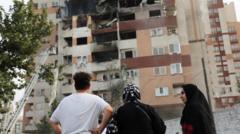Tensions between Israel and Iran transform into an all-out conflict as airstrikes and missile retaliations result in significant casualties and damage, prompting fears of broader regional instability.
**Escalation in Israeli-Iranian Conflict as Attacks Intensify**

**Escalation in Israeli-Iranian Conflict as Attacks Intensify**
Fighting erupts between Israel and Iran following strikes on nuclear facilities, leading to increasing casualties on both sides.
June 14, 2025, marks the second consecutive day of escalating hostilities between Israel and Iran as the conflict becomes increasingly deadly. Israeli military operations targeting Iranian nuclear facilities and leadership have triggered a harsh retaliatory response from Tehran, with missile strikes resulting in casualties that have now exceeded 70 dead in Iran, alongside several injuries and fatalities in Israel.
The Israeli offensive began with airstrikes aimed at strategic nuclear sites, including Natanz, which sustained considerable damage. Reports have surfaced indicating the loss of at least four senior Iranian military commanders during these strikes. In retaliation, Iran has unleashed a barrage of missiles targeting cities near Tel Aviv, causing at least three deaths and numerous injuries, intensifying the conflict that both sides seem unwilling to de-escalate despite international appeals for restraint.
Eyewitness accounts from Tehran convey a sense of fear and disbelief, as residents reported experiencing significant explosions and fires following the initial Israeli strikes. Iranian officials noted a critical failure in air defense preparedness, which contributed to the extensive casualties resulting from Israel's unexpected and aggressive preemptive attacks.
The military engagements have drawn responses from Washington, where leaders are concerned about the potential ramifications of U.S. involvement in the crisis. President Trump has publicly commended Israel's actions while maintaining that the U.S. is not directly participating in the military operations.
As the violence escalates, both nations are faced with mounting losses and the potential for a wider regional conflict, stirring global anxiety over future diplomatic and military developments.
---
In the aftermath of the violent exchanges, various ailing management decisions from both involved parties are being scrutinized, especially the Iranian preparations which led to poor defensive outcomes during the airstrikes. As conflict rages on, the possibility of a diplomatic solution appears increasingly tenuous, raising alarm bells across the geopolitical landscape.
The Israeli offensive began with airstrikes aimed at strategic nuclear sites, including Natanz, which sustained considerable damage. Reports have surfaced indicating the loss of at least four senior Iranian military commanders during these strikes. In retaliation, Iran has unleashed a barrage of missiles targeting cities near Tel Aviv, causing at least three deaths and numerous injuries, intensifying the conflict that both sides seem unwilling to de-escalate despite international appeals for restraint.
Eyewitness accounts from Tehran convey a sense of fear and disbelief, as residents reported experiencing significant explosions and fires following the initial Israeli strikes. Iranian officials noted a critical failure in air defense preparedness, which contributed to the extensive casualties resulting from Israel's unexpected and aggressive preemptive attacks.
The military engagements have drawn responses from Washington, where leaders are concerned about the potential ramifications of U.S. involvement in the crisis. President Trump has publicly commended Israel's actions while maintaining that the U.S. is not directly participating in the military operations.
As the violence escalates, both nations are faced with mounting losses and the potential for a wider regional conflict, stirring global anxiety over future diplomatic and military developments.
---
In the aftermath of the violent exchanges, various ailing management decisions from both involved parties are being scrutinized, especially the Iranian preparations which led to poor defensive outcomes during the airstrikes. As conflict rages on, the possibility of a diplomatic solution appears increasingly tenuous, raising alarm bells across the geopolitical landscape.





















